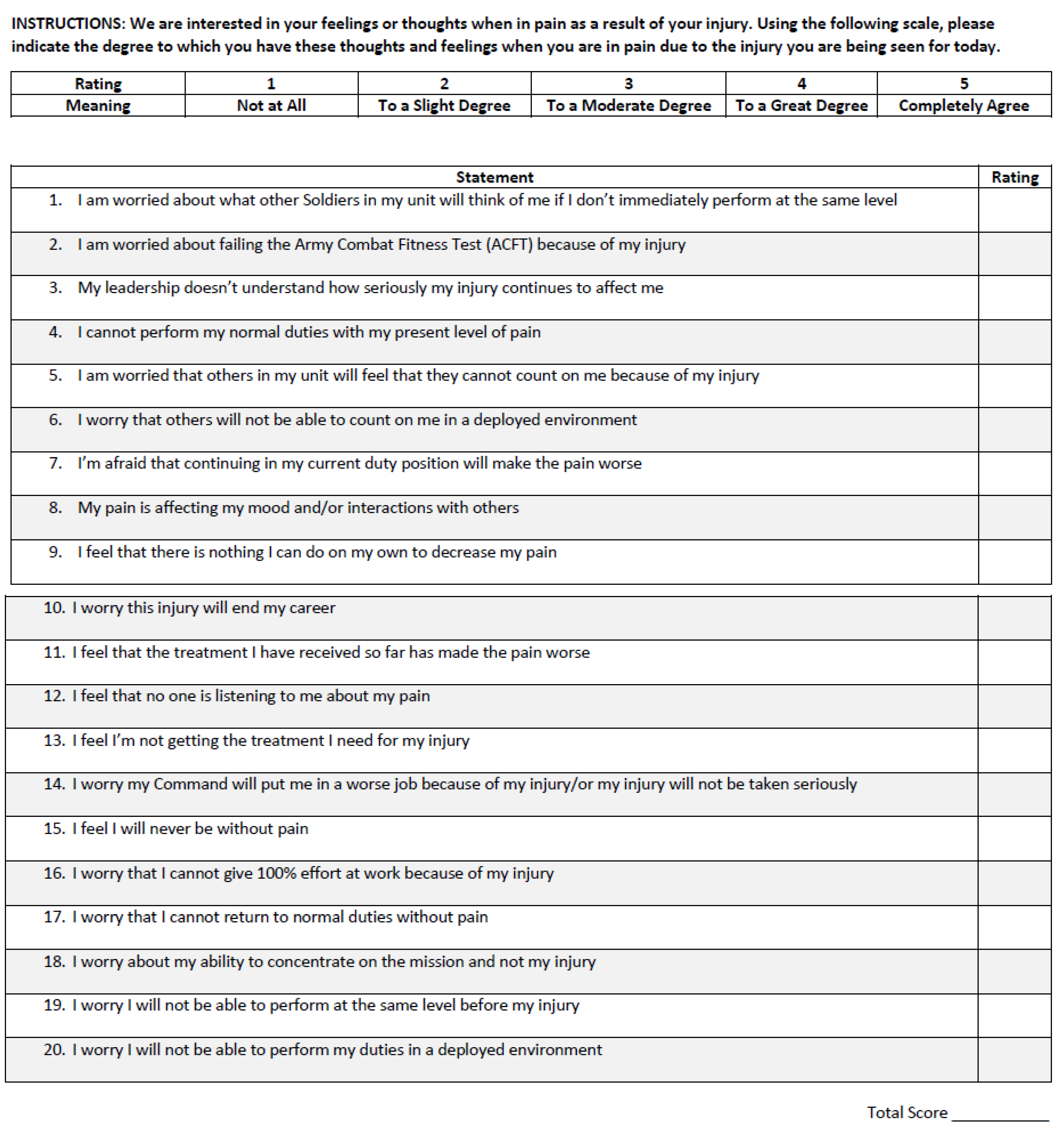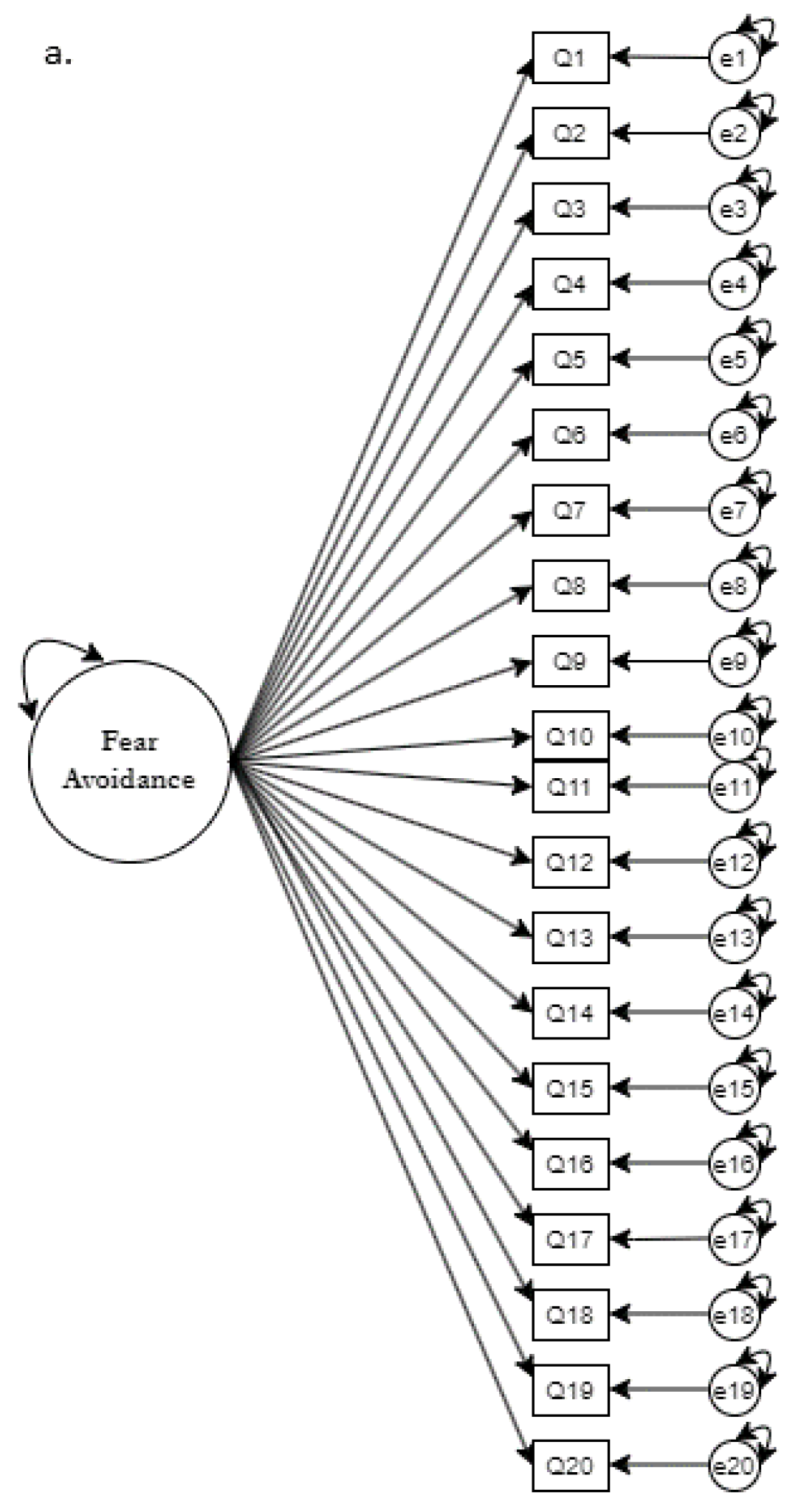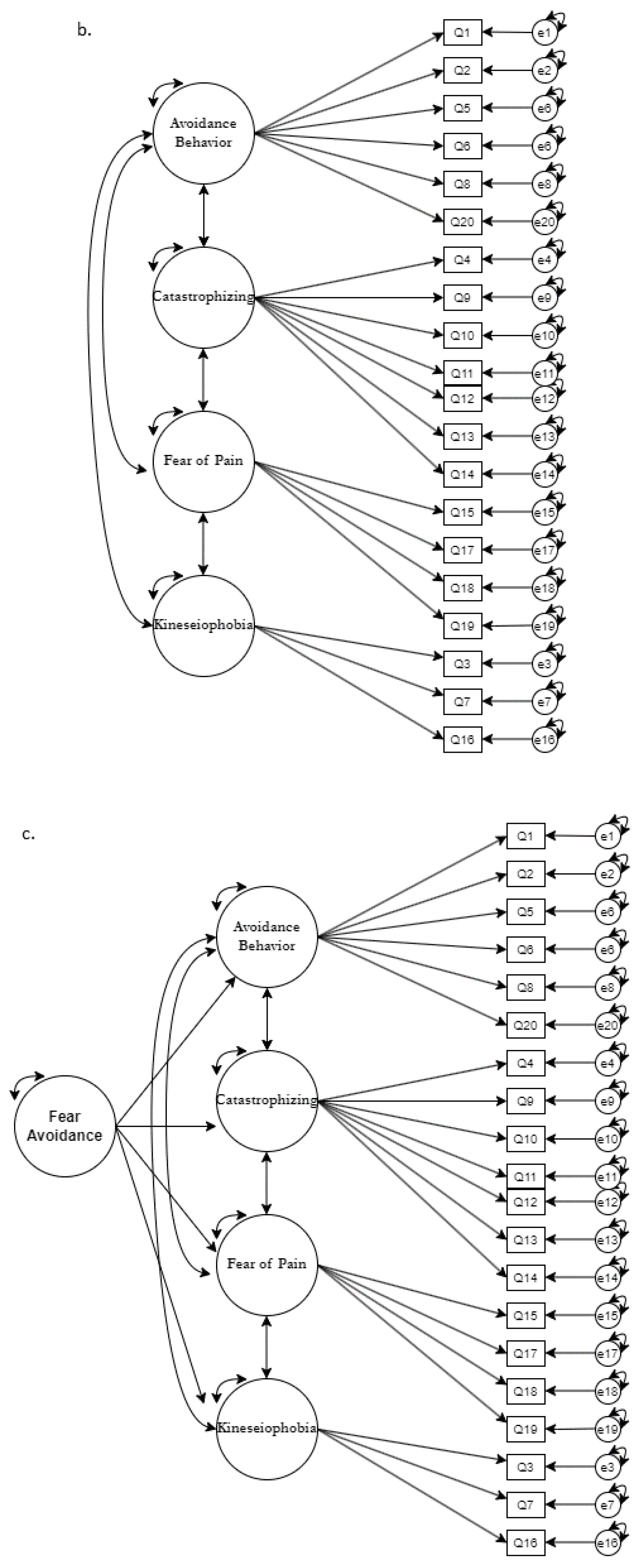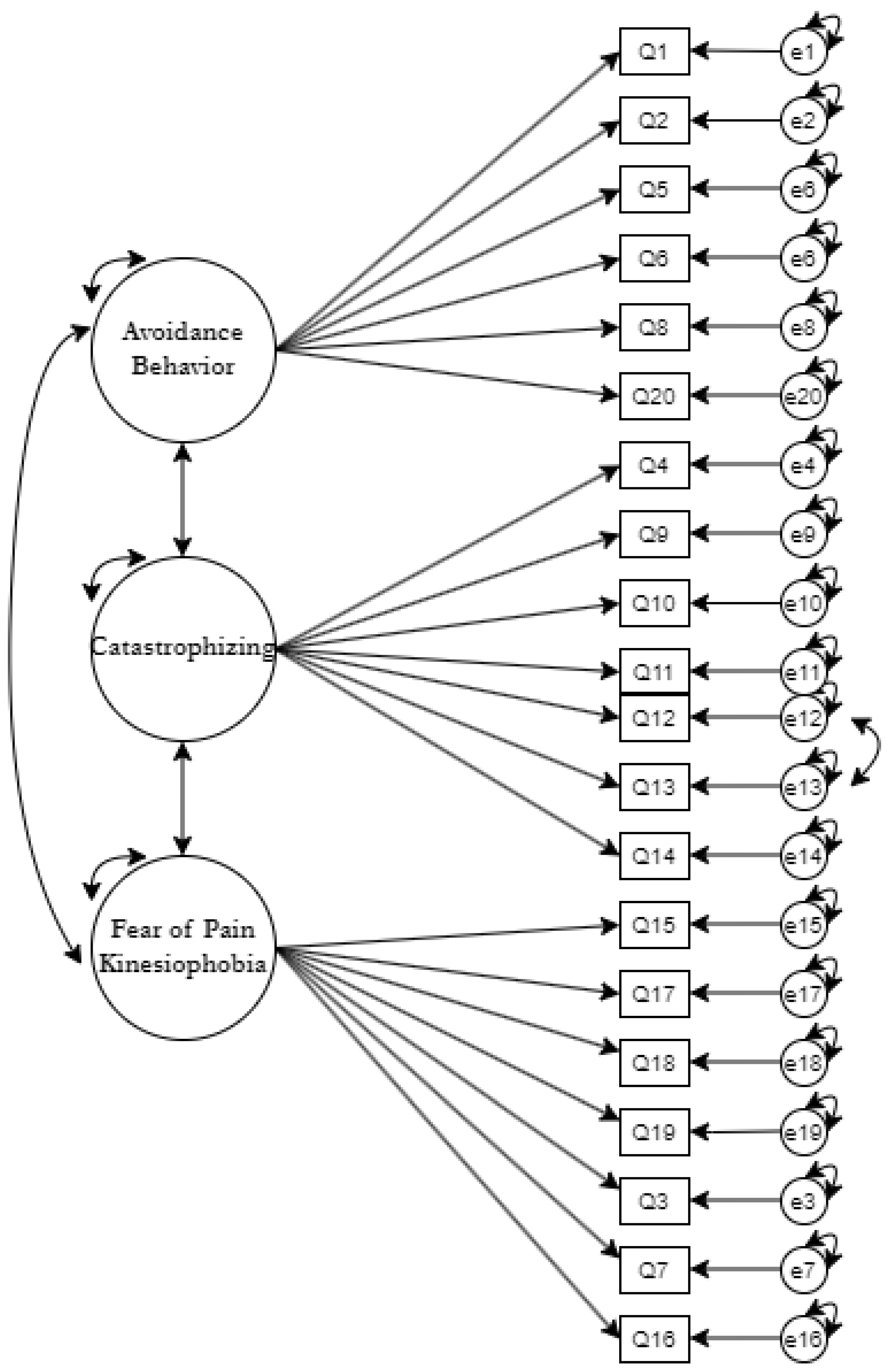A Confirmatory Factor Analysis of the ‘Return to Duty Readiness Questionnaire’
Abstract
1. Introduction
2. Materials and Methods
2.1. Sample and Procedure
2.2. Measures
2.3. Statistical Analyses
3. Results
4. Discussion
4.1. Limitations
4.2. Future Directions & Recommendations
5. Conclusions
Author Contributions
Funding
Institutional Review Board Statement
Informed Consent Statement
Data Availability Statement
Acknowledgments
Conflicts of Interest
Appendix A

References
- McGeary, C.; Nabity, P.; Reed, D.; Cobos, B.; Eapen, B.; Pugh, M.J.; Jaramillo, C.; Potter, J.; Houle, T.; Young-Mccaughan, S.; et al. A test of the fear avoidance model to predict chronic pain outcomes in a polytrauma sample. NeuroRehabilitation 2020, 47, 35–43. [Google Scholar] [CrossRef] [PubMed]
- Liu, H.; Huang, L.; Yang, Z.; Li, H.; Wang, Z.; Peng, L. Fear of movement/(Re)Injury: An update to descriptive review of the related measures. Front. Psychol. 2021, 12, 696762. [Google Scholar] [CrossRef] [PubMed]
- Meyer, V.M. Sport psychology for the soldier athlete: A paradigm shift. Mil. Med. 2018, 183, e270–e277. [Google Scholar] [CrossRef] [PubMed]
- Lethem, J.; Slade, P.D.; Troup, J.D.G.; Bentley, G. Outline of a fear-avoidance model of exaggerated pain perception—I. Behav. Res. Ther. 1983, 21, 401–408. [Google Scholar] [CrossRef]
- Vlaeyen, J.W.S.; Linton, S.J. Fear-avoidance and its consequences in chronic musculoskeletal pain: A state of the art. Pain 2000, 85, 317–332. [Google Scholar] [CrossRef] [PubMed]
- Cooper, C.; Frey, B.; Day, C. Development and validation of a military fear avoidance questionnaire. Front. Rehabil. Sci. 2022, 3, 979776. [Google Scholar] [CrossRef] [PubMed]
- Neblett, R.; Mayer, T.G.; Hartzell, M.M.; Williams, M.J.; Gatchel, R.J. The Fear-avoidance Components Scale (FACS): Development and psychometric evaluation of a new measure of pain-related fear avoidance. Pain Pract. 2016, 16, 435–450. [Google Scholar] [CrossRef] [PubMed]
- Bid, D.; Alagappan, T. Construct validity and factor analysis of the Gujarati version of the fear-avoidance beliefs questionnaire. Physiother. J. Indian Assoc. Physiother. 2019, 13, 30. [Google Scholar] [CrossRef]
- Cuesta-Vargas, A.I.; Roldan-Jimenez, C.; Neblett, R.; Gatchel, R.J. Cross-cultural adaptation and validity of the Spanish fear-avoidance components scale and clinical implications in primary care. BMC Fam. Pract. 2020, 21, 1–9. [Google Scholar] [CrossRef] [PubMed]
- Knezevic, A.; Neblett, R.; Gatchel, R.J.; Jeremic-Knezevic, M.; Bugarski-Ignjatovic, V.; Tomasevic-Todorovic, S.; Boskovic, K.; Cuesta-Vargas, A.I. Psychometric validation of the Serbian version of the Fear Avoidance Component Scale (FACS). PLoS ONE 2018, 13, e0204311. [Google Scholar] [CrossRef] [PubMed]
- Pett, M.A.; Lackey, N.R.; Sullivan, J.J. Making Sense of Factor Analysis the Use of Factor Analysis for Instrument Development in Health Care Research; SAGE Publications: Thousand Oaks, CA, USA, 2003. [Google Scholar]
- Kline, R.B. Principles and Practice of Structural Equation Modeling; The Guildord Plus: London, UK, 2016. [Google Scholar]
- Wickham, H.; Bryan, J. Readxl: Read Excel Files. R Package Version 1.3.1. 2019. Available online: https://CRAN.R-project.org/package=readxl (accessed on 30 April 2022).
- R Core Team. Foreign: Read Data Stored by ’Minitab’, ’S’, ’SAS’ ’SPSS’, ’Stata’, ’Systat’, ’Weka’, ’dBase’,.... R Package Version 0.8-81. 2020. Available online: https://CRAN.R-project.org/package=foreign (accessed on 30 April 2022).
- Rosseel, Y. lavaan: An R package for structural equation modeling. J. Stat. Softw. 2012, 48, 1–36. [Google Scholar] [CrossRef]
- Beaujean, A.A. Latent Variable Modeling Using R: A Step by Step Guide; Taylor & Francis: Abingdon, UK, 2014. [Google Scholar]
- Merck Manual (Consumer Version). Specific Phobic Disorders. Available online: https://www.merckmanuals.com/home/mental-health-disorders/anxiety-and-stress-related-disorders/specific-phobic-disorders (accessed on 11 January 2021).
- Varallo, G.; Giusti, E.M.; Scarpina, F.; Cattivelli, R.; Capodaglio, P.; Castelnuovo, G. The association of kinesiophobia and pain catastrophizing with pain-related disability and pain intensity in obesity and chronic lower-back pain. Brain Sci. 2021, 11, 11. [Google Scholar] [CrossRef] [PubMed]



| Items | N | M | sd | Skewness | Kurtosis |
|---|---|---|---|---|---|
| RDRQ1 | 240 | 1.91 | 1.24 | 1.16 | 0.14 |
| RDRQ2 | 240 | 2.50 | 1.49 | 0.48 | −1.20 |
| RDRQ3 | 240 | 1.92 | 1.29 | 1.25 | 0.31 |
| RDRQ4 | 240 | 2.26 | 1.23 | 0.56 | −0.14 |
| RDRQ5 | 240 | 1.71 | 1.14 | 1.57 | 1.45 |
| RDRQ6 | 240 | 2.02 | 1.38 | 1.12 | −0.11 |
| RDRQ7 | 240 | 2.01 | 1.33 | 1.11 | −0.06 |
| RDRQ8 | 240 | 2.00 | 1.21 | 1.06 | 0.18 |
| RDRQ9 | 240 | 2.28 | 1.35 | 0.75 | −0.66 |
| RDRQ10 | 240 | 1.85 | 1.21 | 1.33 | 0.73 |
| RDRQ11 | 240 | 1.40 | 0.84 | 2.53 | 6.43 |
| RDRQ12 | 240 | 1.58 | 1.09 | 1.87 | 2.46 |
| RDRQ13 | 240 | 1.68 | 1.18 | 1.70 | 1.79 |
| RDRQ14 | 240 | 1.44 | 1.01 | 2.38 | 4.70 |
| RDRQ15 | 240 | 2.34 | 1.41 | 0.67 | −0.89 |
| RDRQ16 | 240 | 2.42 | 1.37 | 0.67 | −0.72 |
| RDRQ17 | 240 | 2.12 | 1.30 | 1.05 | −0.05 |
| RDRQ18 | 240 | 1.78 | 1.11 | 1.33 | 0.80 |
| RDRQ19 | 240 | 2.32 | 1.36 | 0.77 | −0.62 |
| RDRQ20 | 240 | 2.03 | 1.33 | 1.13 | 0.04 |
| Model | χ2 | df | CFI | TLI | RMSEA | SRMR | χ2 Difference |
|---|---|---|---|---|---|---|---|
| Unidimensional | 504.931 | 170 p = 0.000 | 0.834 | 0.815 | 0.091 p = 0.000 90% CI [0.083—0.098] | 0.067 | 0.000028 p < 0.001 |
| Four Factor Model | 427.121 | 164 p = 0.000 | 0.870 | 0.849 | 0.082 p = 0.000 90% CI [0.074—0.090] | 0.066 | |
| Second Order Model | 439.631 | 169 p = 0.000 | 0.855 | 0.849 | 0.082 p = 0.000 90% CI [0.074—0.090] | 0.076 | 0.02761 p = 0.050 |
| Respecified Three-Factor Model | 375.226 | 166 p = 0.000 | 0.897 | 0.882 | 0.072 p = 0.000 90% CI [0.063—0.080] | 0.060 | <0.00001 p < 0.001 |
Disclaimer/Publisher’s Note: The statements, opinions and data contained in all publications are solely those of the individual author(s) and contributor(s) and not of MDPI and/or the editor(s). MDPI and/or the editor(s) disclaim responsibility for any injury to people or property resulting from any ideas, methods, instructions or products referred to in the content. |
© 2022 by the authors. Licensee MDPI, Basel, Switzerland. This article is an open access article distributed under the terms and conditions of the Creative Commons Attribution (CC BY) license (https://creativecommons.org/licenses/by/4.0/).
Share and Cite
Cooper, C.; Frey, B.; Long, H.; Day, C. A Confirmatory Factor Analysis of the ‘Return to Duty Readiness Questionnaire’. Healthcare 2023, 11, 41. https://doi.org/10.3390/healthcare11010041
Cooper C, Frey B, Long H, Day C. A Confirmatory Factor Analysis of the ‘Return to Duty Readiness Questionnaire’. Healthcare. 2023; 11(1):41. https://doi.org/10.3390/healthcare11010041
Chicago/Turabian StyleCooper, Carly, Bruce Frey, Haiying Long, and Charles Day. 2023. "A Confirmatory Factor Analysis of the ‘Return to Duty Readiness Questionnaire’" Healthcare 11, no. 1: 41. https://doi.org/10.3390/healthcare11010041
APA StyleCooper, C., Frey, B., Long, H., & Day, C. (2023). A Confirmatory Factor Analysis of the ‘Return to Duty Readiness Questionnaire’. Healthcare, 11(1), 41. https://doi.org/10.3390/healthcare11010041






